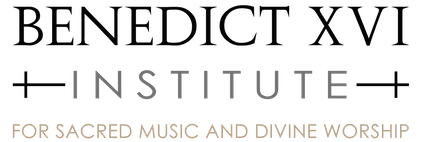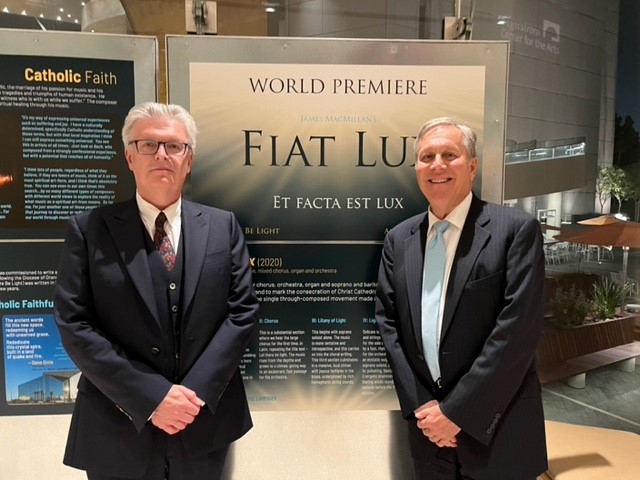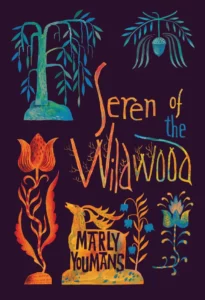On June 20, 2023, Fiat Lux, an oratorio-like liturgical work for singers and orchestra by the Scottish Catholic composer James MacMillan, world-premiered at Christ Cathedral in Garden Grove, California. The cathedral, episcopal seat of the Diocese of Orange just south of Los Angeles County, was perhaps the perfect setting for a musical work whose Latin title translates as “let there be be light,” the first words spoken by God in the Book of Genesis. Designed by architect Philip Johnson, it is a massive structure entirely covered by rectangular glass panes, more than 10,000 of them glued to its steel skeleton, and surmounted by an 18-story spire, also of glass, so that the building sparkles in the sun and daylight floods into its airy interior. It had been built during the 1970s as the ministry center of the late televangelist Robert Schuller, where it had acquired the informal title “Crystal Cathedral.” Schuller’s ministry filed for bankruptcy in 2010, and the Diocese of Orange bought the building and transformed its 3,000-seat sanctuary into a Catholic place of worship.
Fiat Lux, performed by the Pacific Symphony and a 120-voice choir, garnered a rave review from Mark Swed, classical-music critic for the Los Angeles Times. “The 45-minute epic is a work of unfettered exultation and radical religiosity, as weird as it is wondrous,” Swed wrote. That was a tribute to Macmillan, one of the most acclaimed composers of this century, his music saturated with influences ranging from Celtic folk tunes to the Catholic polyphonic treasury. But it was just as much a tribute to Fiat Lux‘s lyricist, Dana Gioia, author of six books of poetry and former poet laureate of the state of California and chairman of the National Endowment for the Arts. Gioia is a California poet to the bone, specifically a Southern California poet. Born in 1950, he grew up in Hawthorne, a working-class suburb of Los Angeles at the south end of the Santa Monica Bay. In Fiat Lux, Dana Gioia makes Macmillan’s music sing in words.
Fiat Lux is divided into five parts. Three of them are musical arrangements of Scripture sung antiphonally by a soprano, a baritone, and a chorus: the Vulgate Bible’s opening of Genesis in Latin and English translation, along with the “You are the light of the world” passage from St. Matthew’s Gospel. Gioia had conceived of this structure himself, as he revealed in a Zoom panel discussion moderated by the Benedict XVI Institute’s Maggie Gallagher that preceded the University of Southern California radio station KUSC’s re-broadcast of the performance on Aug. 13, 2023. “The two soloists are essentially prophetic voices, Gioia said. “At first they become the voice of Genesis, and then they become the voice of the Gospels. And it’s only in the last movement that they all begin singing together….You have, as it were, the choir of angels. There are at creation, you’ve got the assembled people praising life.”
Gioia’s original contributions to the work consist of two stunning choral texts. They are both saturated, not only with images of light and glittering glass, but with images of the cathedral’s—and Gioia’s own—Southern California geography.
The first is a choral litany, “Litany of Light,” with “Let there be light” as the refrain that precedes each of its supplications:
Let there be light,
in the radiance of the August sky,
in the bright globe of the human eye.
Let there be light,
in the rushing wind that came,
Swift in its pentecostal flame.
This is the Southern California landscape distilled: August, the region’s hottest, bone-driest month with its glittering heat and the Santa Ana winds blasting through the canyons and fanning the wildfires that regularly devastate homes and take lives (Gioia nearly lost his own Sonoma County home to the 2019 Kincade Fire). In “Litany of Light” he merges these violent Southern California climate features with the violence of wind and fire that characterized the Holy Spirit’s infusion into the Church on the first Pentecost.
Similarly Gioia’s second text, a final hymn, “Cathedral of Light” also specifically evokes the Southern California landscape:
Upon this rock
Our cross and spire
built in a land
of quake and fire…
Under the sun
of western skies,
we re-enact
the sacrifice.
Bread of the earth,
fruit of the vine,
the tortured flesh
revealed divine.
“Under the sun.” “Quake and fire.” Again, glittering heat and wind-fanned flames—along with the destructive California earthquakes that required Christ Cathedral’s glass panes to be glued to its skeleton, not bolted, so that the structure would sway with the earth’s tremors instead of collapsing. Similarly to what he did the “Litany of Light,” Gioia has fused violent Southern California landscape images with the redemptive violence of Christ’s crucifixion, re-enacted in the Mass. It should also be noted that Gioia’s hymn, in short lines composed of two beats apiece, is eminently singable, even by an untrained congregation.
In 1986 Gioia published a poem, “California Hills in August” that is also about searing sunlight and a dessicated landscape:
I can imagine someone who found
these fields unbearable, who climbed
the hillside in the heat, cursing the dust,
cracking the brittle weeds underfoot,
wishing a few more trees for shade….
And yet how gentle it seems to someone
raised in a landscape short of rain–
the skyline of a hill broken by no more
trees than one can count, the grass,
the empty sky, the wish for water.
The rainless, sun-blasted landscape is the same, the images as vivid, but the approach is completely different. Gioia’s songs in Fiat Lux rely on rhyme, brief and rhythmic lines, and intense vivid images captured in a few words before the song moves on to another brief and intense vivid image. “California Hills in August,” by contrast, is slow-moving and meditative. It is poetry as richly descriptive painting—“the skyline of a hill broken by no more / trees than one can count”–coupled with sound effects–“cracking the brittle weeds underfoot”–that evoke the apparent desolation. There is also an observer—or perhaps more than one observer—through whose eyes the reader experiences the landscape: the hiker “cursing the dust” and the native Californian “raised in a landscape short of rain” who sees the landscape as “gentle,” mitigated by his own memories, perceptions, and longings: “no more / trees than one can count…the empty sky, the wish for water.” “California Hills in August” is a prayer of gratitude for creation; even at its bleakest and most bare-boned, it is a gift. But the reader is obliged to think about all of this as the poem unfolds, perhaps even rereading it several times—and there is no time for thinking or rereading when listening to a song. It would be difficult to set “California Hills in August” to music. (Although such composers as Morton Lauridsen and Ned Rorem have turned some of Gioia’s poems into musical compositions.)
How does a superb poet turn himself into a superb songwriter? For Gioia it might have been easy. Musically trained starting in childhood, he won a scholarship to Stanford University in 1969, where he planned to become a composer. The avant-garde Stanford music department wasn’t interested in the kind of traditional tonal music that Gioia wanted to compose, however, and he turned to poetry, first as an off-hours avocation (with an MBA from Stanford, he was a General Foods executive for 15 years), then as a full-time profession. Although he often writes free verse (“California Hills in August” is an example), he is also aligned with the “New Formalism” movement in poetry that explores traditional rhyme and meter; his aim, he says, is to make his poems accessible to both professional scholars and ordinary people who delight in language. His latest volume of poetry, Meet Me at the Lighthouse (Greywolf Press), published in February 2023, includes a cowboy ballad, “The Ballad of Jesus Ortiz,” about his maternal great-grandfather, a Mexican vaquero who was murdered by a drunken customer while working as a bartender in Wyoming in 1910. It is practically a musical composition in itself:
Three thousand head of cattle
Grazing the prairie grass,
Three thousand head of cattle
Pushed through each mountain pass.
Three thousand head of cattle
Fording the muddy streams,
And then three thousand phantoms
Bellowing in your dreams.
“I love poetry for its sound. To me, poetry is speech raised to the level of song,” Gioia said in an interview with the Santa Rosa Press Democrat shortly after the book’s publication.
The “Lighthouse” in the title of Gioia’s new book Meet Me at the Lighthouse is a venerable jazz club—still standing–in Hermosa Beach, California, not far from Hawthorne. When Gioia was growing up, it featured such jazz stalwarts as Cannonball Adderley and Art Blakey:
Meet me at the Lighthouse on Hermosa Beach,
That shabby nightclub on its foggy pier.
Let’s aim for the summer of ’71,
When all our friends were young and immortal.
Hawthorne itself was the home of the Beach Boys, who were at their apogee of popularity during Gioia’s teen years. His 1985 poem, “Cruising With the Beachboys,” is also about youthful musical memories: the summer of 1969, just before college, driving to the beach in his father’s Thunderbird and singing along with the car radio turned up to full blast:
A primal scream in creaky baritone,
The notes all flat, the lyrics mostly slurred….
In media interviews Gioia has credited pop music from a range of genres and traditions for inspiring the rhythms and clarity of his poems. In an interview with the poetry website Viewless Wings he said: “Working with composers has taught me essential lessons about writing for music….[Y]ou need to keep the surface of the text clear, avoiding excessive density. When writing lyrics, you must create a finished poem that leaves room for the composer to enhance it. The composer is going to change the poem into something richer and different.”
Gioia’s work on Fiat Lux was not his first foray into songwriting. He has written librettos for four operas and is working on a fifth. (One of them, The Magic Feather, a children’s opera written with composer Lori Laitman and based on a Grimm fairy tale, enjoyed its California premier in Walnut Creek, California, in early September 2023.) In 2018 he collaborated with jazz-composer Helen Sung and a group of instrumentalists and singers to produce an album, Sung With Words, that alternately created musical accompaniments to Gioia’s recitations of his poems and turned those same poems into lyrics for Sung’s compositions. Some of those poems found their way into Meet Me at the Lighthouse. Jazz flugelhornist Dmitri Matheny composed background music for Gioia’s YouTube recitation of “Psalm of the Heights,” another of his Lighthouse poems and a love-letter to the city of of Los Angeles as a shimmering nightscape.
So when it came to partnering with James MacMillan on Fiat Lux, Dana Gioia was prepared, fully versed in the ways that a poet must transform his art in order to become a songwriter. In his Aug. 13 Zoom interview for the Benedict XVI Institute he spelled out details: “Don’t put in a lot of adjectives, or if you put in an adjective, the adjective has got to be an extremely meaningful. Get rid of the adverbs, get rid of your dependent clauses, make it streamlined….The words that you have should be significant….[T]he purpose of writing the lyrics is not to make yourself look great as a poet. It’s to make you and the composer together look fantastic as a creative team.
“So I was very conscious of making “Upon this rock, our cross and spire / built in a land of quake and fire”–quake, fire, cross, spire–very simple….The second thing is, part of that is to create a web of sound that the composer can hear, but it’s porous enough that the composer can go into.”
And so Dana Gioia did. Fiat Lux is indeed a web of sound, profound and joyous musical sound projected against glass—and thanks to his magic with stark and quickly rendered images, redolent of his own searing and dusty California home territory:
Rededicate
this crystal spire
built in a land
of quake and fire.
Charlotte Allen is executive editor of Catholic Arts Today.




